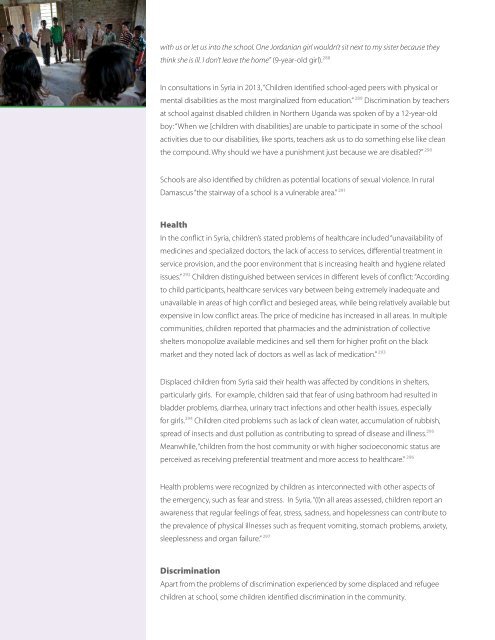putting-children-at-the-heart_full_text_final
putting-children-at-the-heart_full_text_final
putting-children-at-the-heart_full_text_final
- No tags were found...
Create successful ePaper yourself
Turn your PDF publications into a flip-book with our unique Google optimized e-Paper software.
with us or let us into <strong>the</strong> school. One Jordanian girl wouldn’t sit next to my sister because <strong>the</strong>y<br />
think she is ill. I don’t leave <strong>the</strong> home” (9-year-old girl). 288<br />
In consult<strong>at</strong>ions in Syria in 2013, “Children identified school-aged peers with physical or<br />
mental disabilities as <strong>the</strong> most marginalized from educ<strong>at</strong>ion.” 289 Discrimin<strong>at</strong>ion by teachers<br />
<strong>at</strong> school against disabled <strong>children</strong> in Nor<strong>the</strong>rn Uganda was spoken of by a 12-year-old<br />
boy: “When we [<strong>children</strong> with disabilities] are unable to particip<strong>at</strong>e in some of <strong>the</strong> school<br />
activities due to our disabilities, like sports, teachers ask us to do something else like clean<br />
<strong>the</strong> compound. Why should we have a punishment just because we are disabled?” 290<br />
Schools are also identified by <strong>children</strong> as potential loc<strong>at</strong>ions of sexual violence. In rural<br />
Damascus “<strong>the</strong> stairway of a school is a vulnerable area.” 291<br />
Health<br />
In <strong>the</strong> conflict in Syria, <strong>children</strong>’s st<strong>at</strong>ed problems of healthcare included “unavailability of<br />
medicines and specialized doctors, <strong>the</strong> lack of access to services, differential tre<strong>at</strong>ment in<br />
service provision, and <strong>the</strong> poor environment th<strong>at</strong> is increasing health and hygiene rel<strong>at</strong>ed<br />
issues.” 292 Children distinguished between services in different levels of conflict: “According<br />
to child participants, healthcare services vary between being extremely inadequ<strong>at</strong>e and<br />
unavailable in areas of high conflict and besieged areas, while being rel<strong>at</strong>ively available but<br />
expensive in low conflict areas. The price of medicine has increased in all areas. In multiple<br />
communities, <strong>children</strong> reported th<strong>at</strong> pharmacies and <strong>the</strong> administr<strong>at</strong>ion of collective<br />
shelters monopolize available medicines and sell <strong>the</strong>m for higher profit on <strong>the</strong> black<br />
market and <strong>the</strong>y noted lack of doctors as well as lack of medic<strong>at</strong>ion.” 293<br />
Displaced <strong>children</strong> from Syria said <strong>the</strong>ir health was affected by conditions in shelters,<br />
particularly girls. For example, <strong>children</strong> said th<strong>at</strong> fear of using b<strong>at</strong>hroom had resulted in<br />
bladder problems, diarrhea, urinary tract infections and o<strong>the</strong>r health issues, especially<br />
for girls. 294 Children cited problems such as lack of clean w<strong>at</strong>er, accumul<strong>at</strong>ion of rubbish,<br />
spread of insects and dust pollution as contributing to spread of disease and illness. 295<br />
Meanwhile, “<strong>children</strong> from <strong>the</strong> host community or with higher socioeconomic st<strong>at</strong>us are<br />
perceived as receiving preferential tre<strong>at</strong>ment and more access to healthcare.” 296<br />
Health problems were recognized by <strong>children</strong> as interconnected with o<strong>the</strong>r aspects of<br />
<strong>the</strong> emergency, such as fear and stress. In Syria, “(I)n all areas assessed, <strong>children</strong> report an<br />
awareness th<strong>at</strong> regular feelings of fear, stress, sadness, and hopelessness can contribute to<br />
<strong>the</strong> prevalence of physical illnesses such as frequent vomiting, stomach problems, anxiety,<br />
sleeplessness and organ failure.” 297<br />
Discrimin<strong>at</strong>ion<br />
Apart from <strong>the</strong> problems of discrimin<strong>at</strong>ion experienced by some displaced and refugee<br />
<strong>children</strong> <strong>at</strong> school, some <strong>children</strong> identified discrimin<strong>at</strong>ion in <strong>the</strong> community.


